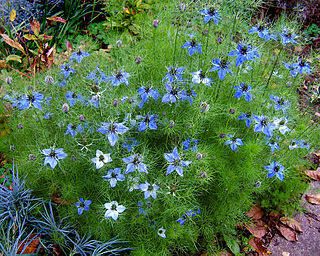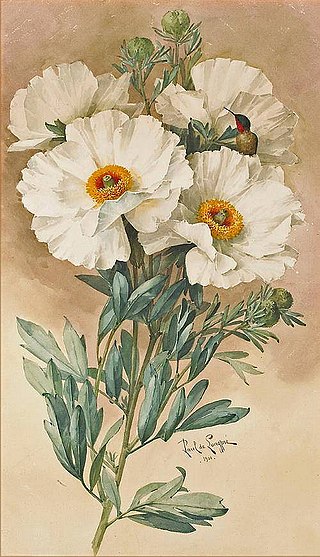
Geranium is a genus of 422 species of annual, biennial, and perennial plants that are commonly known as geraniums or cranesbills. They are found throughout the temperate regions of the world and the mountains of the tropics, with the greatest diversity in the eastern part of the Mediterranean region.

Delphinium is a genus of about 300 species of annual and perennial flowering plants in the family Ranunculaceae, native throughout the Northern Hemisphere and also on the high mountains of tropical Africa. The genus was erected by Carl Linnaeus.

Osteospermum, is a genus of flowering plants belonging to the Calenduleae, one of the smaller tribes of the sunflower/daisy family Asteraceae. They are known as the daisybushes or African daisies.

Nigella damascena, love-in-a-mist, or devil in the bush, is an annual garden flowering plant, belonging to the buttercup family Ranunculaceae. It is native to southern Europe, north Africa and southwest Asia, where it is found on neglected, damp patches of land.

Echeveria is a large genus of flowering plants in the family Crassulaceae, native to semi-desert areas of Central America, Mexico and northwestern South America.

Hyacinthus orientalis, the common hyacinth, garden hyacinth or Dutch hyacinth, is a species of flowering plant in the family Asparagaceae, subfamily Scilloideae, native to southwestern Asia, southern and central Turkey, northwestern Syria, Lebanon and northern Israel. It was introduced to Europe in the 16th century. It is widely cultivated everywhere in the temperate world for its strongly fragrant flowers which appear exceptionally early in the season, and frequently forced to flower at Christmas time.

Hosta is a genus of plants commonly known as hostas, plantain lilies and occasionally by the Japanese name gibōshi. Hostas are widely cultivated as shade-tolerant foliage plants. The genus is currently placed in the family Asparagaceae, subfamily Agavoideae, and is native to northeast Asia. Like many "lilioid monocots", the genus was once classified in the Liliaceae. The genus was named by Austrian botanist Leopold Trattinnick in 1812, in honor of the Austrian botanist Nicholas Thomas Host. In 1817, the generic name Funkia was used by German botanist Kurt Sprengel in honor of Heinrich Christian Funck, a collector of ferns and alpines; this was later used as a common name and can be found in some older literature.

Celosia argentea, commonly known as the plumed cockscomb or silver cock's comb, is a herbaceous plant of tropical origin in the Amaranthaceae family from India and Nepal. The plant is known for its very bright colors. In India and China it is known as a troublesome weed.

Gazania is a genus of flowering plants in the family Asteraceae, native to Southern Africa.

Salvia pratensis, the meadow clary or meadow sage, is a species of flowering plant in the family Lamiaceae, native to Europe, western Asia and northern Africa. The Latin specific epithet pratensis means "of meadows", referring to its preferred habitat. It also grows in scrub edges and woodland borders.

Romneya coulteri, the Coulter's Matilija poppy or California tree poppy, is a perennial species of flowering plant in the poppy family Papaveraceae. Native to southern California, USA, and Baja California, Mexico, it grows in dry canyons in chaparral and coastal sage scrub plant communities, sometimes in areas recently burned. It is a popular ornamental plant, kept for its large, showy flowers.

Lobelia erinus is a species of flowering plant in the bellflower family Campanulaceae, native to southern Africa.

Ipheion uniflorum is a species of flowering plant, related to the onions, so is placed in the allium subfamily (Allioideae) of the Amaryllidaceae. It is known by the common name springstar, or spring starflower. Along with all the species of the genus Ipheion, some sources place it in the genus Tristagma, but research published in 2010 suggested that this is not correct. It is native to Argentina and Uruguay, but is widely cultivated as an ornamental and reportedly naturalized in Great Britain, France, Australia, New Zealand and the United States.

Linaria maroccana is a species of flowering plant in the plantain family known by the common names Moroccan toadflax and annual toadflax. It is native to Morocco, but it can be found elsewhere growing wild as an introduced species, such as California. It is a readily available ornamental plant for the flower garden. This is an annual herb growing erect to approach a maximum height of 50 cm (20 in), its stem with linear leaves 2–4 cm (0.8–1.6 in) long. The inflorescence is a raceme of flowers occupying the top of the stem. At the base of each flower is a calyx with five narrow, pointed lobes. The flower is 2–4 cm (0.8–1.6 in) long with five lobes arranged into two lips with a spur at the end. The flower is often purple in color with white near the throat, but flowers of many different colors are bred for the garden. Dwarf cultivars are also available.

Nemesia caerulea is a blue- to purple- flowered herbaceous perennial member of the family Scrophulariaceae. The plant is native to the Cape Floristic Province of southwestern South Africa, where it grows at low elevations on fully exposed north-facing and northwest-facing slopes in association with other native grasses and forbs. Its chromosome number is 2n=18.

Muscari aucheri, Aucher-Éloy grape hyacinth, is a species of flowering plant in the squill subfamily Scilloideae of the asparagus family Asparagaceae. It is a perennial bulbous plant, one of a number of species and genera known as grape hyacinths. Originally from Turkey, where it grows in grassy alpine areas, it is sometimes grown as an ornamental plant. The synonym M. tubergenianum may be found in the horticultural literature.

Galega, goat's rue, is a genus of flowering plants in the legume family, Fabaceae, native to central and southern Europe, western Asia and tropical east Africa. They are tall, bushy, herbaceous perennials with erect racemes of pea-like flowers in shades of white, pink, blue or mauve. Their preferred habitats are sunny damp meadows or slopes.

Ceratostigma willmottianum, Chinese plumbago, is a species of flowering plant in the family Plumbaginaceae that is native to western China and Tibet. It is an ornamental deciduous shrub that grows to 1 metre in height, with pale blue plumbago-like flowers appearing in autumn as the leaves start to turn red.

Plectranthus oertendahlii is a species of flowering plant in the sage and mint family, Lamiaceae. Common names include silverleaf spurflower, Swedish ivy, Oertendahl's spurflower, November lights, and Brazilian coleus though it is native to eastern South Africa rather than Brazil. Plectranthus oertendahlii and the cultivar ‘Uvongo’ have gained the Royal Horticultural Society’s Award of Garden Merit.

Nemesia denticulata, the toothed aloha, is a species of flowering plant in the genus Nemesia of the figwort family Scrophulariaceae, native to South Africa. A mat‑forming perennial useful for borders, it has gained the Royal Horticultural Society's Award of Garden Merit.





















